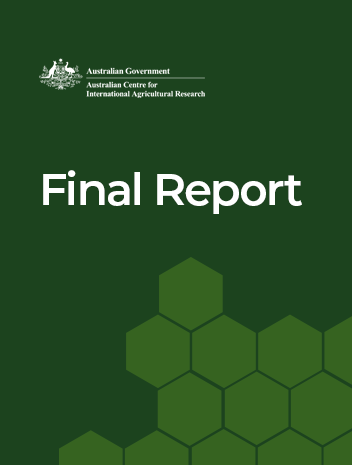- HomeHome
-
About ACIAR
- Our work
- Our people
-
Corporate information
- ACIAR Audit Committee
- Commission for International Agricultural Research
- Policy Advisory Council
- Agency reviews
- Executive remuneration disclosure
- Freedom of information (FOI)
- Gifts and benefits register
- Information publication scheme
- List of new agency files
- Contracts
- Legal services expenditure
- Privacy impact assessment register
- Commonwealth Child Safe Framework
- Benefits to Australia
- Careers
- 40 years of ACIAR
-
What we do
- Programs
- Cross-cutting areas
- Resources
- Where we work
-
Funding
- Research projects
- Fellowships
-
Scholarships
- John Allwright FellowshipScholarships to study in Australia for ACIAR partner country scientists to have Australian postgraduate qualifications
- ACIAR Pacific Agriculture Scholarships and Support and Climate Resilience Program
- Alumni Research Support Facility
- Publications
- News and Outreach
Project final report
Bamboo agroforestry in East Nusa Tenggara - Final Report
Date released
23 January 2023
ISBN
978-1-922787-20-0
Publication Code
FR2023-003
Overview
This project aimed to test and refine bamboo agroforestry approaches that can be adopted and scaled out for greater effectiveness within the national-Government supported Sustainable Bamboo Forestry and 1000 Bamboo Villages programs.
Bamboo is an integral part of many Indonesia communities, and the increased global demand for bamboo products is being viewed by the Indonesia government as an opportunity to enhance rural livelihoods.
The steppingstone for this research was to enable further development of commercially viable, evidence-based, sustainable bamboo agroforestry options for Indonesian smallholders; and to contribute to the formulation of a standardised process for selecting, appraising, and developing potential bamboo agroforestry landscapes for relevant government initiatives.
Broad literature review was conducted in sites already intervened by the Environmental Bamboo Foundation (EBF) and sites with the potentials for bamboo village establishment. Village appraisal methods, data collection for geospatial analysis, and past reports review on existing EBF business implementation and social-governance partnership activities were gathered and summarised to identify current conditions and lessons learned. This provided insights for establishing a robust and proved methodology for appraisals and cultivation procedures, and a basis for implementing social-governance infrastructure under bamboo village mechanism.
Although the methodologies were applicable to be scaled up nationally within the partnership of the government, local organisations, and local communities, there were no fit-for-all methodologies. The methods should be tailored with the variety of village conditions, the generalisation of the scale must be determined, and each biogeochemical condition should have different cultivation treatments.



